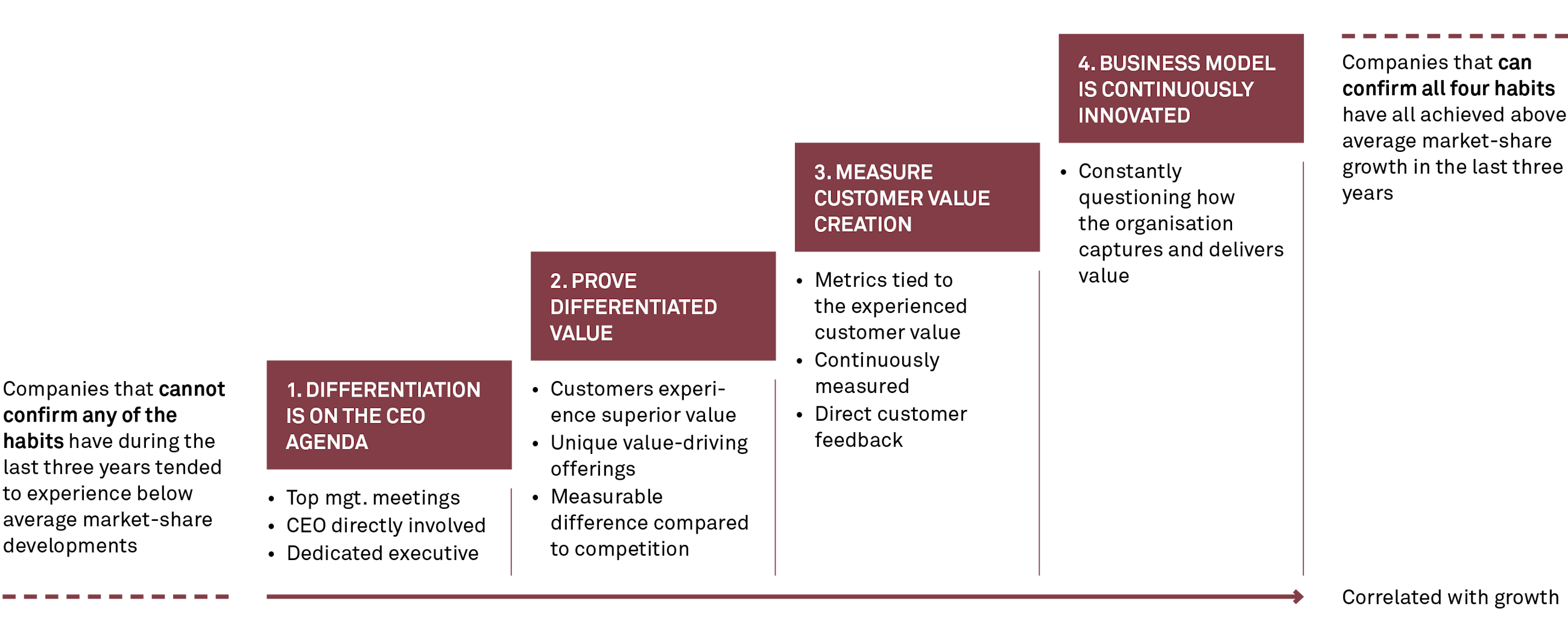How winning companies create a differentiated market position and consistently capture value.
6 April 2016
It is becoming increasingly difficult for companies to differentiate their core offerings. To combat the trends of price pressure and commoditisation, an Implement Consulting Group study has identified four habits that characterise winning companies (above-average market share development in the past three years) and their differentiation efforts. These companies;
- have a differentiation strategy at the top of the management agenda,
- are able to prove and deliver differentiated value to their target customers,
- continuously measure customer value creation, and
- relentlessly innovate throughout their business model to maintain and develop new differentiators.
It is not easy to compete in the modern marketplace. Standing out amongst growing competition, surviving brutal price wars and tending with the forces of commoditisation are critical challenges. Most corporate leaders are aware that differentiation is key to survival, but very few companies are able to differentiate successfully in practice.
We recently conducted a study of some of Scandinavia’s largest firms to understand how they tackle these issues. Within this group, a selection of winning companies emerged – those with above average market share growth over the past three years. This group, which made up just 6 % of the companies studied, all rely on a similar set of differentiation activities, and they do so on such a consistent basis that they have become ingrained habits. These habits are only collectively enacted by winning companies, and they consist of the four following categories:
1. Differentiation strategy at the top of the agenda
In an age where agility is key, identifying opportunities to differentiate can mean the difference between stagnation or growth. But without top management commitment and oversight, differentiation can easily drift into the abyss of corporate bureaucracy and become nothing more than a marketing communication activity. Winning companies have differentiation as a strategic priority, and the choices concerning “how to win” are continuously discussed and driven by the CEO. Furthermore, “differentiation development” is a core agenda point for every executive management meeting, which together with a clear governance and incentive structure, ensures progression and commitment throughout the organisation.
With a CEO who spearheads differentiation efforts, organisations can quickly realise a wide range of benefits:
- It signals the importance of differentiation to the whole organisation.
- It increases the spread and adoption of differentiation-thinking throughout the business.
- It creates clearer functional strategies as the strategic direction and ambition concerning differentiation is set by top management.
Questions CEOs should ask themselves:
- Is differentiation a core element of your key strategic choices and priorities?
- Is progress on differentiation efforts followed up on at every executive meeting?
2. Prove differentiated value
Most companies use significant resources on analysing and documenting the features and benefits of their own products and solutions, focusing on areas where they believe to have a competitive advantage. However, only 35 % of companies in our study have a solid understanding of what truly drives value for their customers.
Winning companies act differently. First they develop unique value-driving offerings for specific customer segments. For each of the segments and even individual customers, they can document a measurable difference compared to competitors as well as prove the specific financial value for the customer. The delivery of differentiated value is then defined for every touch point in the customer experience. Finally, these realisations are then documented to provide tangible proof of value creation to new leads and prospects. This approach, of having clearly defined and proven differentiators, results in a number of financial benefits:
- It allows higher value capture and profitability as differentiation drives the ability to command a price premium towards selected segments and customers
- It leads to higher win rates through higher perceived value creation and perceived uniqueness in relation to the competition
Questions CEOs should ask themselves:
- Can you measurably prove the “delta to competition” of your offerings?
- Can you prove and articulate superior value creation for your key customers?
3. Measure customer value creation
If you ask a typical company whether they measure customer value, most would answer with a resounding “yes”. Then they would proceed to explain how they track things like customer lifetime value, customer satisfaction and turnover/profitability per customer. While these are all important metrics for commercial and operational purposes, they do not help to measure the company’s differentiation, and how much value the customer actually experiences.
Winning companies instead measure aspects that are tied to the experienced customer value. This includes metrics such as total profit of ownership and customer loyalty metrics such as NPS® (Net Promoter Score®). However, their full value is only extracted when the company’s score is analysed in relation to competitors. Winning companies measure these aspects of delivery consistently and on a customer-specific basis in real time. The best performers even take direct customer feedback and deliver it to responsible employees, who are given the means and authority to contact the customer directly to resolve issues.
Building a customer value measurement system that allows for tracking, analysis and follow-up based on customer value metrics has several benefits:
- It provides decision-makers with relevant data on how the company is satisfying the needs of customers independently and in relation to competition
- It aligns front-line employees’ actions with customer value drivers and gives them the means to follow up on and improve the customer experience
- It allows the company to continuously improve its offerings with a foundation in leading indicators of differentiation
Questions CEOs should ask themselves:
- Is experienced customer value tracked and measured consistently?
- Are front-line employees provided with real-time customer feedback and the authority to ratify issues when they arise?
4. Innovate relentlessly
Ensuring long-term growth means being able to differentiate consistently in the midst of the choppy waters of the modern business environment. Winning companies do this by continuously seeking to innovate and differentiate throughout the business model. Innovation in this sense is not confined to product innovation – instead, it is a matter of systematic questioning of every component of how the organisation delivers and captures value. To fertilise this culture, winning companies have performance management criteria that measure employees’ contribution to reengineering the company’s business model. The most advanced companies establish an autonomous organisational unit with a mandate to explore future directions without the same performance targets and customers as the main business.
Relentlessly seeking to innovate and differentiate throughout the business model brings with it several benefits:
- The required agility to change pace and/or direction when the external environment demands it
- The distinct ability to differentiate from competition in new areas of the business model in accordance with current and future customer needs
- The long-term competitiveness required to win in the modern marketplace
To foster a relentlessly innovating differentiation machine is not easy. It requires a long-term commitment to restlessness, intellectual curiosity and questioning of existing paradigms. As a result, it cannot just be an ad hoc activity – it must become an ingrained part of the organisation’s culture and way of working.
Questions CEOs should ask themselves:
- Is relentless innovation facilitated by autonomous innovation units and organisation-wide encouragement of questioning existing working practices?
- Are incentive structures in place that promote the questioning of the entire business model?
Conclusion
The four habits may seem like par for the course, but sadly many organisations find themselves deep in the woods despite widespread awareness of solutions. Committing to a differentiation strategy that permeates the entire organisation, that is driven by delivering and measuring proven superior customer value compared to competition, and whose business model is relentlessly questioned are all demanding routines that require constant attention.
Although it may take years to implement such habits, a natural starting point is to develop a differentiation mindset. The whole organisation must be focused on delivering differentiated and superior customer value, before change can happen and winning can occur. In the words of renowned NFL coach Bill Walsh: “Champions behave like champions before they’re champions: they have a winning standard of performance before they are winners”. What will your winning standard of differentiation be?
Case
Svitzer is the world’s largest towage company, operating 450 tugboats in 40 countries around the world. In 2012 the company joined forces with Implement Consulting Group to develop a strategy to accelerate global growth. According to Svitzer’s CCO Kasper Friis Nilaus, at the time “we didn’t talk much about what the customer really needed. We had a product, we sold it, and we emphasized the product’s features.” Through a painstaking process of understanding both customer needs and internal capabilities, Svitzer is now dedicated to a strategy that revolves around regularly proving differentiated value to their globally-dispersed customer base.
Realising the differentiation strategy starts with setting up continuous tracking of customer needs and above all their needs in the buying process. To resonate with customers in the best possible way, local drivers of differentiated customer value are developed in addition to the company’s global differentiators. These differentiators are consistently measured in delivery, providing Svitzer with the ability to prove customer value gains both locally and globally.
Since starting their differentiation journey, Svitzer has effectively doubled their win-rates of new projects. Committing to habits related to delivering and measuring differentiated customer value generation has been at the heart of their strategy, and the trend continues to point upward for Svitzer.





